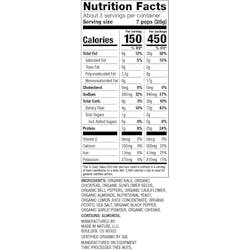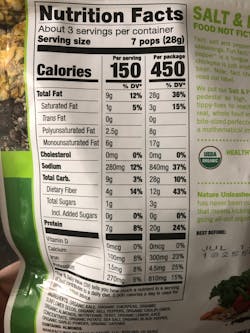Health & Fitness: Firefighter Nutrition: Understanding Nutrition Labels
What if I told you that your best nutrition resource is right in front of you? It’s not a gigantic nutrition book, a specific study, or even a restrictive diet; it’s a nutrition label. The goal of this article is to bring you back to the basics and make you a powerful consumer by simply reading the nutrition labels on your food. This article will present what we can learn from a nutrition label, ingredients to watch out for, and how to simplify nutrition through your food-shopping list.
Nutrition labels provide us with a glance of how a food can fit within a balanced diet and lifestyle, as well as how the food can impact our health based on ingredients and nutrients present. Here’s what we can learn from a nutrition label:- Calories (energy provided by the food consumed for one serving)
- Serving size (defined amount of food listed; note that this is different than portion, which is the amount of food you actually eat)
- Macronutrients (carbohydrates, fats and protein)
- Micronutrients (specific vitamins and minerals)
- Cholesterol (dietary cholesterol)
- Sodium (sodium content)
- Fiber (form of carbohydrate, associated with various health benefits, such as weight management, satiety, digestion, and heart health)
- Sugar (total amount of sugar within a product in grams, as well as “added sugar” in grams; these numbers allow you to understand what products have naturally occurring sugars compared to others that have sugar that’s been added into a product)
- Ingredients present (list of ingredients listed in order of volume from greatest to least)
- Certifications (standards for certain dietary restrictions, agricultural practices, or work conditions of employees; example: “organic”)
- Allergy statement (includes common food allergens contained within the product; transparent information for those with allergies or dietary restrictions)
Ingredients to watch
There are several items listed on the nutrition label that need special consideration. Here is a list of ingredients to watch out for.Added Sugar—There are over 50 names for different added sugars! Consuming too much added sugar is associated with various nutrition-related conditions, such as obesity, heart health, diabetes, and more. Look to see if “added sugar” is listed, then check the ingredients list—if the word ends in “ol,” or “ose,” or includes the word syrup, then it’s a form of sugar. Something important to keep in mind is that despite turning to less processed sugars, the body doesn’t discriminate against sugar that much to an extent; it’s all sugar and adds up quickly.
Sodium—Despite the Dietary Guidelines recommendation of less than 2,300mg of sodium (1 teaspoon of salt), the average American consumes more (averaging 3,400mg according to the CDC). Excessive sodium intake has been linked to increased blood pressure and heart-health risks.
Dietary cholesterol—For many years it was portrayed that dietary cholesterol impacts our blood cholesterol levels, which in turn impacts our heart health. After various studies contrasted this association, the most recent Dietary Guidelines stop concentrating on dietary cholesterol as one of concern (the exception is for the minority of individuals who are susceptible to the effects of dietary cholesterol). Instead the Dietary Guidelines focus on understanding how different types of fat within our diets, in addition to overall diet, can impact our heart health instead of vilifying naturally occurring cholesterol containing foods (ex: eggs and shellfish).
Trans fat—Trans fat, or hydrogenated oils, are industrial-produced fats added to products because they’re inexpensive and can increase shelf life. They’ve been studied for their negative associations with heart health, which has made companies aware of decreasing them. They can still be found in some processed items like baked goods, margarine, and even peanut butter. Be aware that a product is technically “trans-fat free” if it has less than 0.5g of trans fat per serving, so once again the ingredients on your nutrition label are your friends! Check the ingredients for partially or hydrogenated oils to be safe.
Preservatives, gums, fillers, emulsifiers and stabilizers—These ingredients are not naturally found in products and are mainly present in food to preserve freshness, increase shelf stability, or to keep the product intact. Some can add sodium content (preservatives) and others may have the potential to cause GI distress (gums), so they’re ingredients to try to keep at a minimum, if possible.Buyer beware
Avoid living by buzzwords and health and wellness trends! The food industry is great at capitalizing on this and uses it in their marketing to pull you in—just because a label says, “great source of antioxidants,” “all natural,” “fat free,” or “organic,” doesn’t mean that it’s the healthiest choice. In fact, it might mean the complete opposite. For example, for an item to be fat free (especially when there’s a full fat version of the product) you must think, “How did they make this fat free?” Usually these products have added sugars, gums or preservatives to make up for what’s lost and make it taste good. In many cases, it’s best to consume the original version, stick to a serving size or two, and enjoy it; instead of having an even more processed version, and going overboard on the serving sizes because you think it’s “healthier.” When in doubt, the easiest piece of advice to steer clear of ingredients that you might be questioning is if they pass this simple test—if you have difficulty pronouncing the ingredients, then they’re most likely questionable, such as being a form of sugar, filler, preservative, etc.Lastly, it’s important not to dismiss a nutrition label, especially when buzzwords are used. Remember that an organic cookie is still a cookie, so although one might have better quality ingredients than the other, we still need to look at them as cookies when it comes to how they fit within a balanced diet. When you see a buzzword, ask yourself what these terms actually mean and if it’s beneficial to be eating those products. We shouldn’t be giving them a health halo (putting them on a pedestal) if they have these trendy words. Like with anything else, we should continue to check the facts by looking at the ingredients and quality of the food.
Simplifying nutrition
One of the most common complaints I hear in the firehouse is that nutrition is too confusing and forever changing. Nutrition has become so complicated, but it doesn’t have to be. The best way to make it simpler is to aim to consume whole foods or those with minimal ingredients. When turning to convenience products, such as prepared items and mainly snacks or treats, remember their purpose. They can fit within a balanced and healthy lifestyle if that lifestyle mainly consists of whole food options; it’s when the convenience items that have many ingredients, some questionable, take over within your diet that there becomes a cause for concern. When looking at labels, some of the best nutrition options usually don’t have them! Aim for incorporating more foods that don’t usually have labels, such as fruits, vegetables, quality animal protein, etc., with the occasional convenience or packaged item that meets your personal health standards, in addition to enjoyment.About the Author

Dana Harrison
Dana Harrison, MS, is a nutritionist and educator who is based in Massachusetts. She received a bachelor’s degree in biology from Vassar College and a master’s degree in nutrition science (community nutrition concentration) from University of Massachusetts Amherst. Harrison is the founder of The Cultural Shift Method, which is a nutrition education program that makes nutrition, health and wellness easy, individualized and attainable. She presents simple, realistic, sustainable and dynamic plans for positive health and wellness behaviors, which allow for changes to occur on a cultural level. For more information, visit www.eats2know.com or contact her at [email protected].







